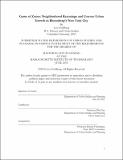Game of zones : neighborhood rezonings and uneven urban growth in Bloomberg's New York City
Author(s)
Goldberg, Leo (Leo Michael)
DownloadFull printable version (7.559Mb)
Alternative title
Neighborhood rezonings and uneven urban growth in Bloomberg's New York City
Other Contributors
Massachusetts Institute of Technology. Department of Urban Studies and Planning.
Advisor
Phil Clay.
Terms of use
Metadata
Show full item recordAbstract
Between 2002 and 2014, the Bloomberg administration implemented dozens of neighborhood-scale rezonings to catalyze economic growth and create the conditions for new residential development. With the amount of housing affordable to low- and moderate-income households diminishing every year and a new administration publically committed to addressing the city's housing challenges, it is an opportune moment to consider the motivation for and impact of the Bloomberg administration's rezoning program. Though individual rezonings have been subject to extensive scrutiny, little research has been done to assess the technical, social, and political dimensions of the rezoning program as a whole. This thesis explores the way in which Bloomberg administration rezonings guided growth spatially and how that growth affected access to housing for households at various income levels and of different races. Data on development and demographic change suggest that the rezonings facilitated new housing growth in prime, central neighborhoods at the expense of low- and moderate-income renters. In low-density areas, the city conducted rezonings that preserved neighborhoods from new development, but, in combination with an influx of immigrants and renter households, contributed to increasing rent burdens and overcrowding. The quantitative analysis demonstrates that, on aggregate, rezonings were associated with residential displacement in and near the city's core while serving to exclude low-income households in the periphery. An analysis of the social and political context of the rezonings indicates that while the Department of City Planning was motivated by infrastructural and economic considerations, the interests of nongovernmental stakeholders shaped the rezoning program to a significant extent. Homeowner mobilizations produced downzonings particularly in Staten Island, eastern Queens and southern Brooklyn. Meanwhile, development interests spurred rezonings in commercial and industrial areas as well as gentrifying neighborhoods, inducing a sharp increase in housing costs and residential dislocation. While one portion of the rezoning program embodied the interests of homeowners, another was driven by the demands of the development community, resulting in divergent outcomes that undermined access to housing for New Yorkers of limited means. This thesis suggests changes to New York City's planning and zoning mechanisms to more effectively realize citywide growth goals while responding to the particular needs of low-income, largely non-white households.
Description
Thesis: M.C.P., Massachusetts Institute of Technology, Department of Urban Studies and Planning, 2015. This electronic version was submitted by the student author. The certified thesis is available in the Institute Archives and Special Collections. Cataloged from student-submitted PDF version of thesis. Includes bibliographical references (pages 116-127).
Date issued
2015Department
Massachusetts Institute of Technology. Department of Urban Studies and PlanningPublisher
Massachusetts Institute of Technology
Keywords
Urban Studies and Planning.